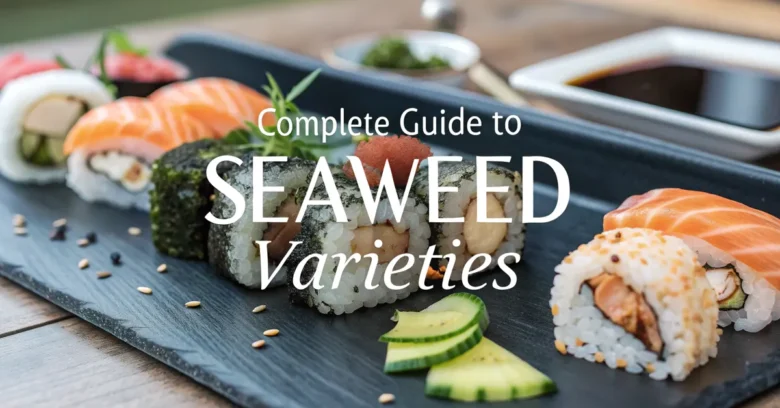Are you ready to dive into the world of sushi like never before? One of the most essential components that complete sushi is the seaweed. But it’s much more than a simple wrap. The right seaweed, or nori, can elevate your culinary experience. But with so many choices available, it’s not easy to pick one.
In this guide, we’ll explore the different seaweed types you can find, discuss their unique tastes and uses, and give you the info you need to choose the perfect seaweed for your sushi and other dishes. Whether you’re a seasoned sushi chef or just starting out, this guide will help you understand the seaweeds out there and how to use them.
A Deep Dive into Seaweed: More Than Just a Wrap
Seaweed has been a core part of diets in different parts of the world for ages, in places such as Japan, Korea, and China. It’s not just valued for its special taste but also for its dietary value. Rich in minerals, vitamins, and antioxidants, seaweed is more than just a tasty addition; it’s a boost to your health.
When it comes to sushi, seaweed is very important. It adds a distinct flavor, texture, and visual appeal to the dish. But with a wide array of seaweed types at your disposal, knowing which one to pick for your sushi is key to making a dish that truly stands out.
The Nutritional Powerhouse: Why Seaweed is Good for You
Before we dive into the different types of seaweed, let’s take a quick look at why it’s considered a superfood:
- Rich in Minerals: Seaweed is packed with minerals like iodine, calcium, magnesium, and iron, which are essential for different body functions.
- Source of Vitamins: It contains vitamins A, C, E, and B vitamins, contributing to overall health and well-being.
- Antioxidant Properties: Seaweed has antioxidants that help protect your body against damage from free radicals.
- Fiber Content: It’s a good source of dietary fiber, which aids in digestion and can help manage weight.
- Iodine Source: Seaweed is one of the best natural sources of iodine, vital for thyroid function.
Knowing the good things about seaweed can help you value it more as a food choice, not just for making sushi but also as a way to boost your health.
Decoding the Ocean’s Bounty: Common Seaweed Types
Now, let’s dive into the heart of the matter: different seaweed types. Each type has unique traits, flavor profiles, and uses in cooking. Here are some of the most common ones:
Nori: The Sushi Staple
Nori is maybe the most well-known type of seaweed, very common in sushi. It’s made by shredding seaweed, pressing it into thin sheets, and drying it, almost the same way paper is made.
- Flavor and Texture: Nori has a distinct savory taste with a hint of the sea. Its texture is thin, crispy, and slightly papery.
- Common Uses: Mainly used for making sushi rolls, onigiri (rice balls), and as a garnish for noodle soups.
- Grading Nori: Nori is graded on a scale with letters and numbers. The best nori is graded as A, and after that is B, C, etc. The highest quality nori is very shiny, dark green, and even in color. You should always look at the date printed on the nori package and choose the latest date. If the nori has tiny holes or is torn in places, it is probably not the highest grade of nori.
- Buying Tips: When you buy nori, look for sheets that are dark green, smooth, and free of holes. Roasted nori is a popular choice, adding more flavor and crispness.
- Good to Know: When using nori for sushi, make sure to keep it in a dry place, because it can easily absorb dampness from the rice, and this will make it very chewy and hard to eat. Don’t let the nori touch the damp rice until you are ready to roll the sushi.
Wakame: The Silky Seaweed
Wakame is another popular seaweed, known for its silky texture and subtle sweet taste.
- Flavor and Texture: It has a mild, slightly sweet flavor and a smooth, silky texture when rehydrated.
- Common Uses: A common ingredient in miso soup and seaweed salads. It can also be added to soups and stews for extra flavor.
- Buying Tips: You can buy wakame in dried or fresh form. Dried wakame needs to be rehydrated before use, and it will expand a lot, so use it sparingly.
- Good to Know: Wakame has fucoxanthin, a compound studied for its possible effects on fat metabolism.
Kombu: The Flavor Enhancer
Kombu is very important in Japanese cuisine, prized for its umami taste and used to make dashi, a base stock for many dishes.
- Flavor and Texture: Kombu has a rich umami taste, thanks to its high glutamate content. Its texture is thick and leathery when dried, softening as it cooks.
- Common Uses: Used to make dashi, the base for miso soup, noodle broths, and simmered dishes. It can also be pickled or eaten as a snack.
- Buying Tips: Look for thick, wide, and unbroken kombu pieces with a natural gloss. White powder on the surface is good; it’s glutamate, which adds taste.
- Good to Know: When using kombu to make dashi, don’t boil it, because it can make the broth bitter. Gently simmer it to get the most flavor.
Dulse: The Red Seaweed
Dulse is a red seaweed with a distinct reddish-purple color and a slightly spicy taste.
- Flavor and Texture: Dulse has a slightly spicy, nutty taste. When fresh, it’s soft and chewy; when dried, it becomes crispy.
- Common Uses: It can be eaten as a snack, added to salads, or used to flavor soups and stews. It can also be toasted for a crispy treat.
- Buying Tips: Dulse is available in dried or flake form. Look for a deep red color and a fresh sea smell.
- Good to Know: Dulse has all the essential amino acids, making it a good source of protein for vegetarians and vegans.
Sea Lettuce: The Delicate Green
Sea lettuce is a type of green seaweed with thin, translucent leaves that look like lettuce.
- Flavor and Texture: It has a mild, slightly salty taste and a tender texture.
- Common Uses: It’s added to salads, soups, and stir-fries. It can also be used as a wrap for small appetizers.
- Buying Tips: Fresh sea lettuce should be bright green and free of any bad smell. Dried sea lettuce should be rehydrated before use.
- Good to Know: Sea lettuce is rich in iron and vitamin C, making it a healthy addition to your diet.
Arame: The Mild and Versatile
Arame is a type of brown seaweed with a mild, slightly sweet taste and a firm texture.
- Flavor and Texture: Arame has a mild, slightly sweet taste and a firm, slightly chewy texture.
- Common Uses: It’s often used in salads, stir-fries, and simmered dishes. It absorbs flavors well, making it great for different recipes.
- Buying Tips: Arame is usually sold dried. Look for a dark brown color and a natural sea smell.
- Good to Know: Arame is rich in calcium, iron, and fiber, making it a healthy addition to your meals.
The Art of Selection: Choosing the Right Seaweed for Your Dish
Choosing the right seaweed can make a big difference in your dish. Here are some tips to help you pick the best seaweed for different purposes:
- For Sushi Rolls: Nori is the best choice for sushi rolls. Its thin, flexible sheets are easy to roll, and its savory taste matches well with rice and fillings.
- For Miso Soup: Wakame is a traditional ingredient in miso soup. Its silky texture and mild taste add a nice touch to the broth.
- For Seaweed Salads: Wakame and sea lettuce are great choices for seaweed salads. Their tender textures and mild flavors go well with dressings and other veggies.
- For Broths and Stocks: Kombu is ideal for making broths and stocks. Its umami flavor adds depth and richness to soups and stews.
- For Snacks: Dulse can be eaten as a snack. Its slightly spicy and nutty taste makes it a tasty and healthy choice.
- For Stir-Fries: Arame can be added to stir-fries for extra texture and flavor. It absorbs sauces well, making it a versatile addition to any stir-fry recipe.
Beyond Sushi: Creative Ways to Use Seaweed
While seaweed is often linked to sushi, there are many other ways to use it in your cooking:
- Seaweed Flakes as Seasoning: Crush dried seaweed into flakes and use it as a seasoning for soups, salads, and roasted veggies.
- Seaweed in Smoothies: Add a small amount of seaweed to your smoothies for a boost of minerals and vitamins.
- Seaweed in Baking: Mix seaweed flakes into bread dough or muffin batter for a boost of nutrition and a subtle savory taste.
- Seaweed as a Wrap: Use large seaweed sheets as a wrap for rice, veggies, and protein for a healthy and flavorful meal.
- Seaweed in Soups and Stews: Add seaweed to soups and stews for extra flavor and nutrition.
- Seaweed Butter: Mix softened butter with seaweed flakes and use it as a spread for bread or a topping for seafood and veggies.
Sourcing Your Seaweed: What to Look For
When buying seaweed, it’s very important to choose good quality products from reliable sources. Here are some things to keep in mind:
- Check the Label: Look for seaweed that is clearly labeled with its type, origin, and harvest date.
- Look for Certifications: Choose seaweed that is certified organic or sustainably harvested to make sure it’s good for the environment.
- Consider the Source: Buy seaweed from reliable suppliers who follow strict quality control measures.
- Check the Appearance: Look for seaweed with a bright, natural color and no signs of damage or mold.
- Smell the Seaweed: Fresh seaweed should have a pleasant sea smell. Avoid seaweed that smells bad or stale.
Storing Seaweed: Keeping It Fresh
Proper storage is key to keeping the quality and flavor of seaweed. Here are some tips:
- Store in a Cool, Dry Place: Keep seaweed in a cool, dry place away from direct sunlight and heat.
- Use an Airtight Container: Store seaweed in an airtight container to prevent it from absorbing dampness and losing flavor.
- Refrigerate After Opening: Once you open a package of seaweed, refrigerate it to keep it fresh.
- Use Desiccant Packs: Add desiccant packs to your seaweed containers to absorb dampness and extend its shelf life.
- Check for Expiration Dates: Always check the expiration dates on seaweed packages and use them before they expire.
Seaweed Around the World: Regional Variations
Seaweed is used in different cuisines all over the world, each with its own special ways of using and preparing it. Here are some examples:
- Japan: In Japan, seaweed is a core part of the diet, used in sushi, soups, salads, and snacks. Nori, wakame, and kombu are some of the most common types.
- Korea: Korean cuisine features seaweed in many dishes, such as miyeok guk (seaweed soup), gim (dried seaweed), and bibimbap (mixed rice).
- China: Seaweed is used in Chinese medicine and cuisine, often added to soups, stir-fries, and salads for its health benefits.
- Ireland: Dulse is a traditional food in Ireland, eaten as a snack or added to soups and stews.
- Wales: Laver is a type of seaweed used to make laverbread, a traditional Welsh dish made by cooking and pureeing seaweed.
Common Questions About Seaweed
Here are some common questions about seaweed:
- Is seaweed safe to eat? Yes, seaweed is generally safe to eat. However, it can contain high levels of iodine, so it’s best to eat it in moderation.
- Can I eat seaweed if I have a thyroid condition? If you have a thyroid condition, talk to your doctor before eating seaweed, because it can affect thyroid function.
- Is seaweed good for vegetarians and vegans? Yes, seaweed is a good source of protein, vitamins, and minerals for vegetarians and vegans.
- Can I grow my own seaweed? Yes, it’s possible to grow your own seaweed, but it requires specific conditions and equipment.
- How do I prepare dried seaweed? To prepare dried seaweed, rehydrate it in water for a few minutes until it softens. Then, use it in your recipes as needed.
Making the Most of Seaweed
Now that you know everything about different seaweed types, their uses, and benefits, you can start trying out with seaweed in your cooking. Whether you’re making sushi, soups, salads, or snacks, seaweed can add a unique flavor and nutritional boost to your dishes.
Should You Dive into the World of Seaweed?
Exploring the world of seaweed opens up a world of culinary and health benefits. With its different types, flavors, and uses, seaweed offers a unique way to boost your meals and nourish your body. So, why not dive in and discover all that seaweed has to offer?



